On the Grain Microstructure–Mechanical Properties Relationships in Aluminium Alloy Parts Fabricated by Laser Powder Bed Fusion
Abstract
:1. Introduction
2. Materials and Methods
2.1. Samples Preparation
2.2. Electron Back Scatter Diffraction (EBSD)
2.3. Nanoindentation
2.4. Tensile Test
3. Results and Discussion
3.1. Grain Pattern Appearance in 3D-Printed RS-333 Alloy
3.2. Nanoindentation of 3D-Printed RS-333 Alloy: Youngs’ Modulus and Hardness
3.3. Tensile Test of 3D-Printed RS-333 Alloy: The Influence of Surface Quality
4. Conclusions
Author Contributions
Funding
Data Availability Statement
Acknowledgments
Conflicts of Interest
Appendix A
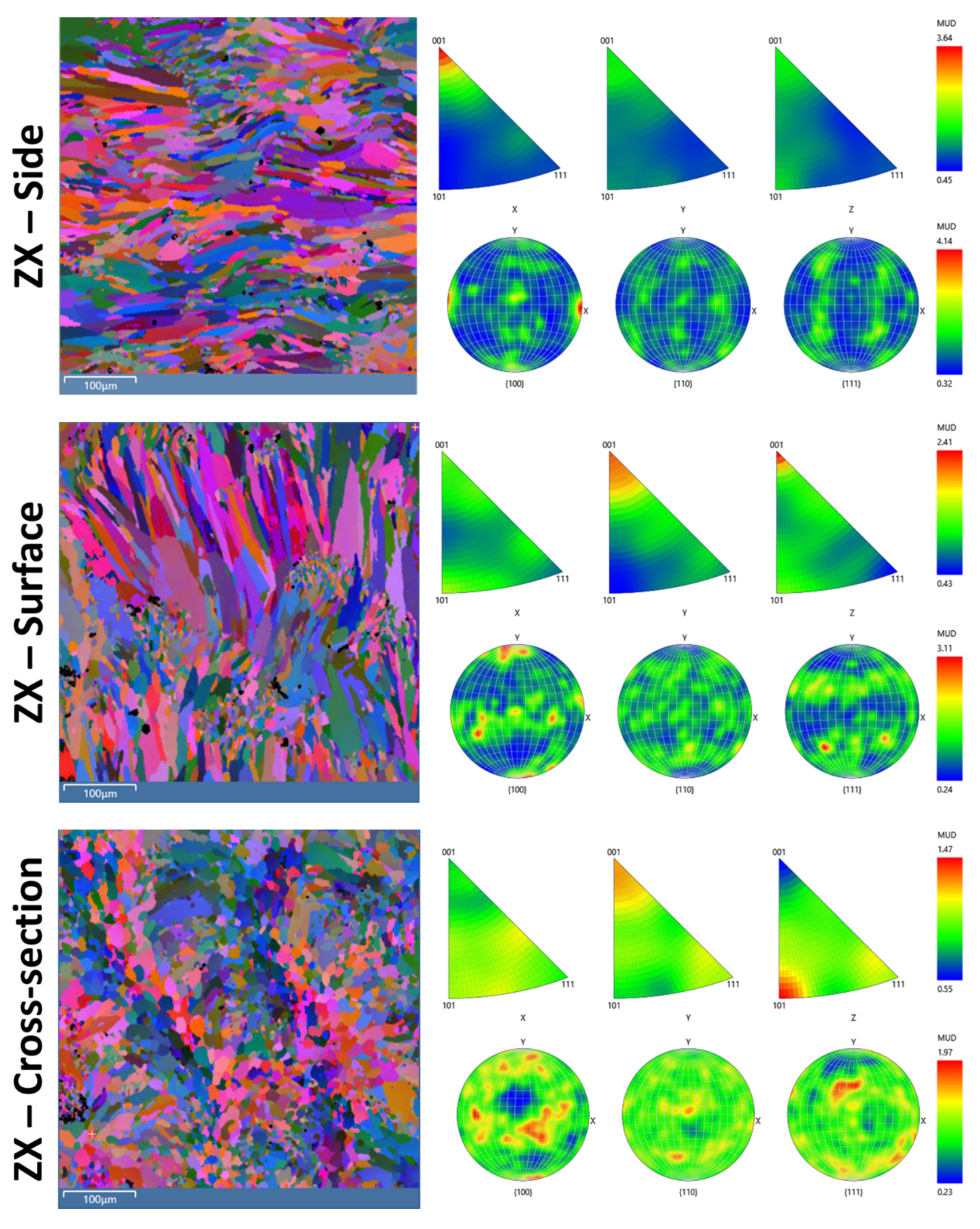
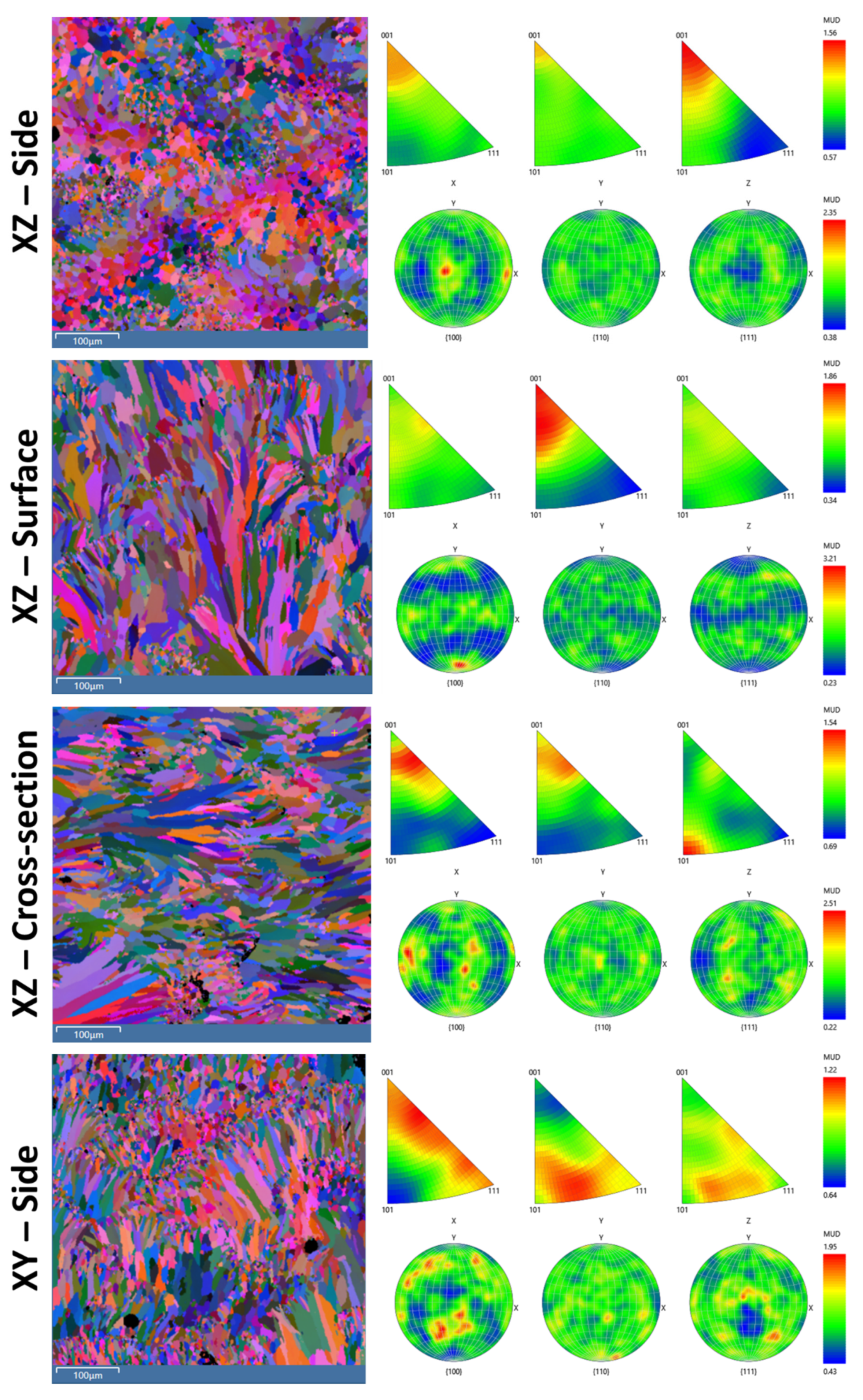
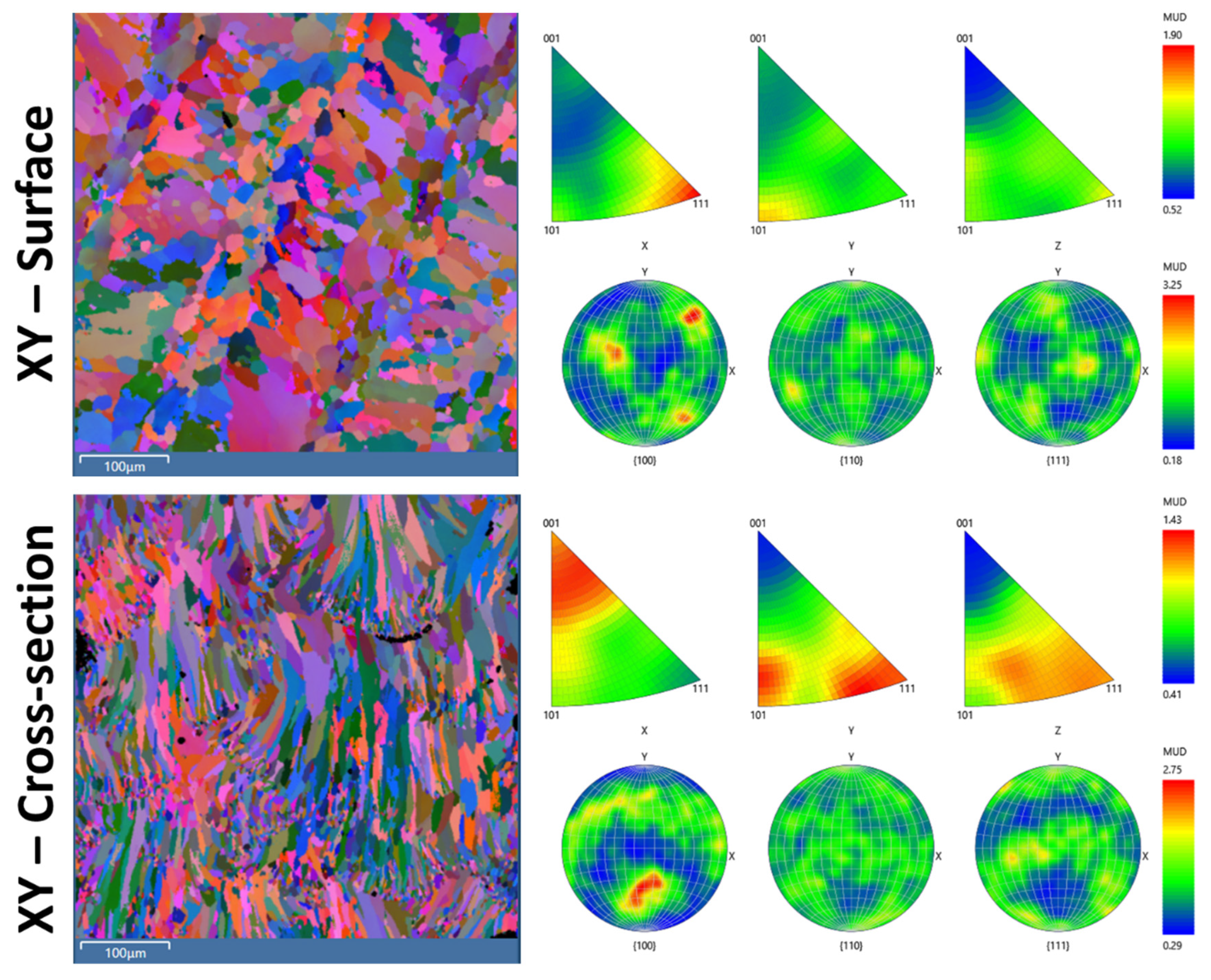
References
- Munir, K.; Biesiekierski, A.; Wen, C.; Li, Y. Selective laser melting in biomedical manufacturing. In Metallic Biomaterials Processing and Medical Device Manufacturing; Woodhead Publishing: Oxford, UK, 2020; pp. 235–269. [Google Scholar] [CrossRef]
- Zhang, L.-C.; Wang, J.; Liu, Y.; Jia, Z.; Liang, S.-X. Additive Manufacturing of Titanium Alloys. Ref. Modul. Mater. Sci. Mater. Eng. 2020. [Google Scholar] [CrossRef]
- Song, X.; Zhai, W.; Huang, R.; Fu, J.; Fu, M.; Li, F. Metal-Based 3D-Printed Micro Parts & Structures. Ref. Modul. Mater. Sci. Mater. Eng. 2020. [Google Scholar] [CrossRef]
- New Nickel 3D Printing Powder Ideal for Gas Turbine Production. Available online: https://www.pesmedia.com/eos-nickel-additive-manufacturing-18022021/ (accessed on 6 June 2021).
- Multi-Metal 3D Printed Gas Turbine. Available online: https://www.materialstoday.com/additive-manufacturing/products/multimetal-3d-printed-gas-turbine/ (accessed on 6 June 2021).
- Satellite Detail Produced through 3D Printing by RUSAL Successfully Works in Space. Available online: https://www.spotlightmetal.com/satellite-detail-produced-through-3d-printing-by-rusal-successfully-works-in-space-a-998012/ (accessed on 6 June 2021).
- Nguyen, D.-S.; Park, H.-S.; Lee, C.-M. Applying Selective Laser Melting to Join Al and Fe: An Investigation of Dissimilar Materials. Appl. Sci. 2019, 9, 3031. [Google Scholar] [CrossRef] [Green Version]
- Xiong, W.; Hao, L.; Li, Y.; Tang, D.; Cui, Q.; Feng, Z.; Yan, C. Effect of selective laser melting parameters on morphology, microstructure, densification and mechanical properties of supersaturated silver alloy. Mater. Des. 2019, 170, 107697. [Google Scholar] [CrossRef]
- Kluczyński, J.; Śnieżek, L.; Grzelak, K.; Janiszewski, J.; Płatek, P.; Torzewski, J.; Szachogłuchowicz, I.; Gocman, K. Influence of Selective Laser Melting Technological Parameters on the Mechanical Properties of Additively Manufactured Elements Using 316L Austenitic Steel. Materials 2020, 13, 1449. [Google Scholar] [CrossRef] [Green Version]
- Pekok, M.A.; Setchi, R.; Ryan, M.; Han, Q.; Gu, D. Effect of process parameters on the microstructure and mechanical properties of AA2024 fabricated using selective laser melting. Int. J. Adv. Manuf. Technol. 2021, 112, 175–192. [Google Scholar] [CrossRef]
- Subbiah, R.; Bensingh, J.; Kader, A.; Nayak, S. Influence of printing parameters on structures, mechanical properties and surface characterization of aluminium alloy manufactured using selective laser melting. Int. J. Adv. Manuf. Technol. 2020, 106, 5137–5147. [Google Scholar] [CrossRef]
- Koutny, D.; Skulina, D.; Pantelejev, L.; Paloušek, D.; Lenczowski, B.; Palm, F.; Nick, A. Processing of Al-Sc aluminum alloy using SLM technology. Procedia CIRP 2018, 74, 44–48. [Google Scholar] [CrossRef]
- Statnik, E.S.; Nyaza, K.V.; Salimon, A.I.; Ryabov, D.; Korsunsky, A.M. In Situ SEM Study of the Micro-Mechanical Behaviour of 3D-Printed Aluminium Alloy. Technologies 2021, 9, 21. [Google Scholar] [CrossRef]
- Liu, X.; Zhao, C.; Zhou, X.; Shen, Z.; Liu, W. Microstructure of selective laser melted AlSi10Mg alloy. Mater. Des. 2019, 168, 107677. [Google Scholar] [CrossRef]
- Bouledroua, O.; Meliani, M.H.; Azari, Z.; Sorour, A.; Merah, N.; Pluvinage, G. Effect of Sandblasting on Tensile Properties, Hardness and Fracture Resistance of a Line Pipe Steel Used in Algeria for Oil Transport. J. Fail. Anal. Prev. 2017, 17, 890–904. [Google Scholar] [CrossRef]
- Oliver, W.C.; Pharr, G.M. An improved technique for determining hardness and elastic modulus using load and displacement sensing indentation experiments. J. Mater. Res. 1992, 7, 1564–1583. [Google Scholar] [CrossRef]
- Hay, J.C.; Bolshakov, A.; Pharr, G.M. A critical examination of the fundamental relations used in the analysis of nanoindentation data. J. Mater. Res. 1999, 14, 2296–2305. [Google Scholar] [CrossRef] [Green Version]
- Yetna N’Jocka, M.; Roudet, F.; Idriss, M.; Bartier, O.; Chicot, D. Work-of-indentation coupled to contact stiffness for calculating elastic modulus by instrumented indentation. Mech. Mater. 2016, 94, 170–179. [Google Scholar] [CrossRef]
- Blaber, J.; Adair, B.; Antoniou, A. Ncorr: Open-Source 2D Digital Image Correlation Matlab Software. Exp. Mech. 2015, 55, 1105–1122. [Google Scholar] [CrossRef]
- Ponnusamy, P.; Rahman Rashid, R.A.; Masood, S.H.; Ruan, D.; Palanisamy, S. Mechanical Properties of SLM-Printed Aluminium Alloys: A Review. Materials 2020, 13, 4301. [Google Scholar] [CrossRef] [PubMed]
- Tiryakioğlu, M.; Robinson, J.C.; Salazar-Guapuriche, M.A.; Zhao, Y.Y.; Eason, P.D. Hardness–strength relationships in the aluminum alloy 7010. Mater. Sci. Eng. A 2015, 631, 196–200. [Google Scholar] [CrossRef]
- Korsunsky, A.M. On the Hill and Kolmogorov statistics and the K-function representation of judiciously modified Avrami kinetics. arXiv 2021, arXiv:2103.11728. [Google Scholar]
- Salvati, E.; Korsunsky, A.M. An analysis of macro- and micro-scale residual stresses of Type I, II and III using FIBDIC micro-ring-core milling and crystal plasticity FE modelling. Int. J. Plast. 2017, 98, 123–138. [Google Scholar] [CrossRef]
- Everaerts, J.; Salvati, E.; Uzun, F.; Romano Brandt, L.; Zhang, H.J.; Korsunsky, A.M. Separating macro- (Type I) and micro- (Type II.III) residual stresses by ring-core FIB-DIC milling and eigenstrain modelling of a plastically bent titanium alloy bar. Acta Mater. 2018, 156, 43–51. [Google Scholar] [CrossRef]
- Salvati, E.; Romano Brandt, L.; Mughal, Z.; Sebastiani, M.; Korsunsky, A.M. Generalised residual stress depth profiling at the nanoscale using focused ion beam milling. J. Mech. Phys. Solids 2019, 125, 488–501. [Google Scholar] [CrossRef]
- Chen, J.W.; Korsunsky, A.M. Why is local stress statistics normal, and strain lognormal? Mater. Des. 2021, 198, 109319. [Google Scholar] [CrossRef]
- Korsunsky, A.M. A Teaching Essay on Residual Stresses and Eigenstrains; Butterworth-Heinemann: Oxford, UK, 2017; ISBN 9780128109908. [Google Scholar]
- Salvati, E.; Lunt, A.J.G.; Heason, C.P.; Baxter, G.J.; Korsunsky, A.M. An analysis of fatigue failure mechanisms in an additively manufactured and shot-peened IN718 nickel superalloy. Mater. Des. 2020, 191, 108605. [Google Scholar] [CrossRef]


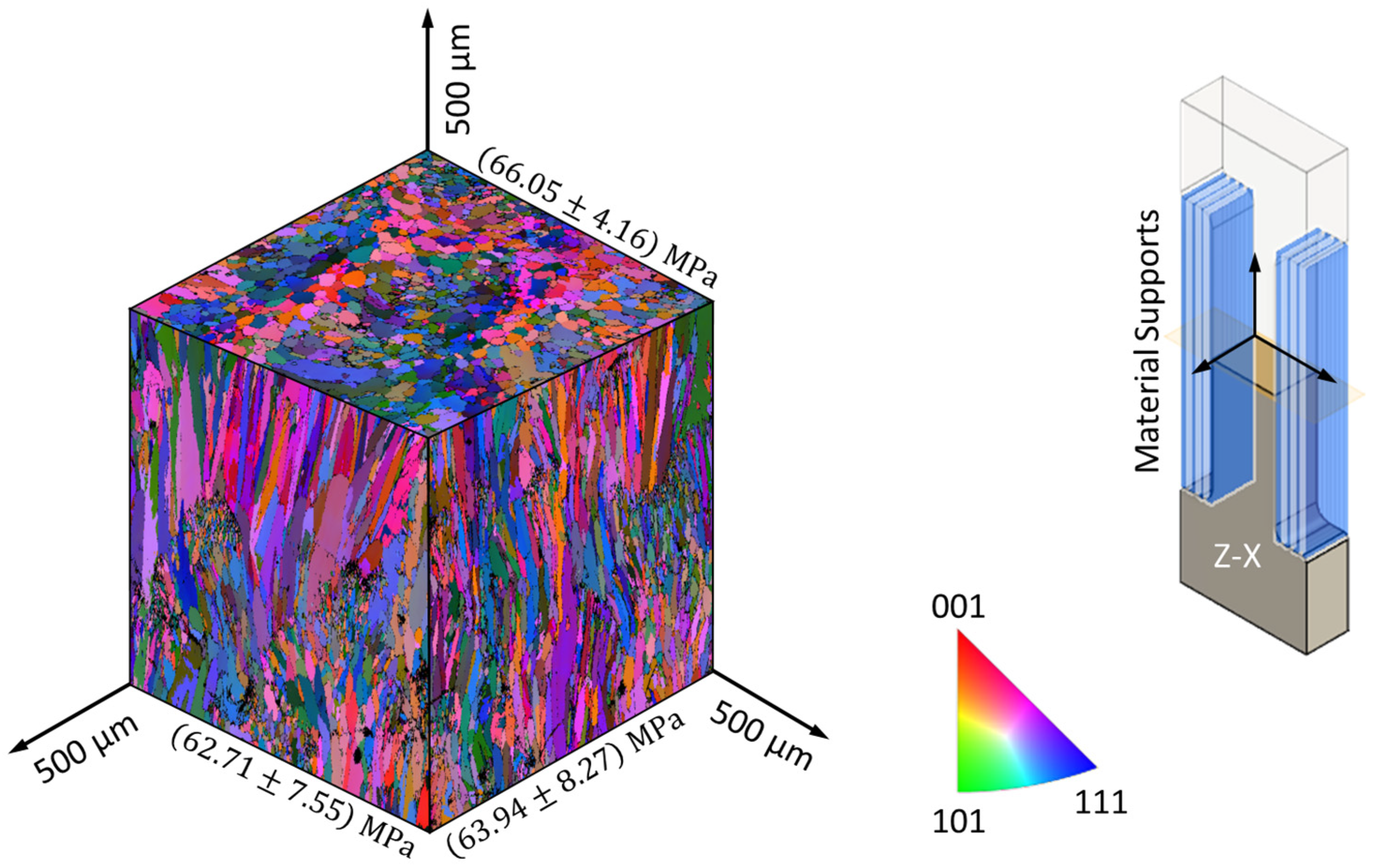
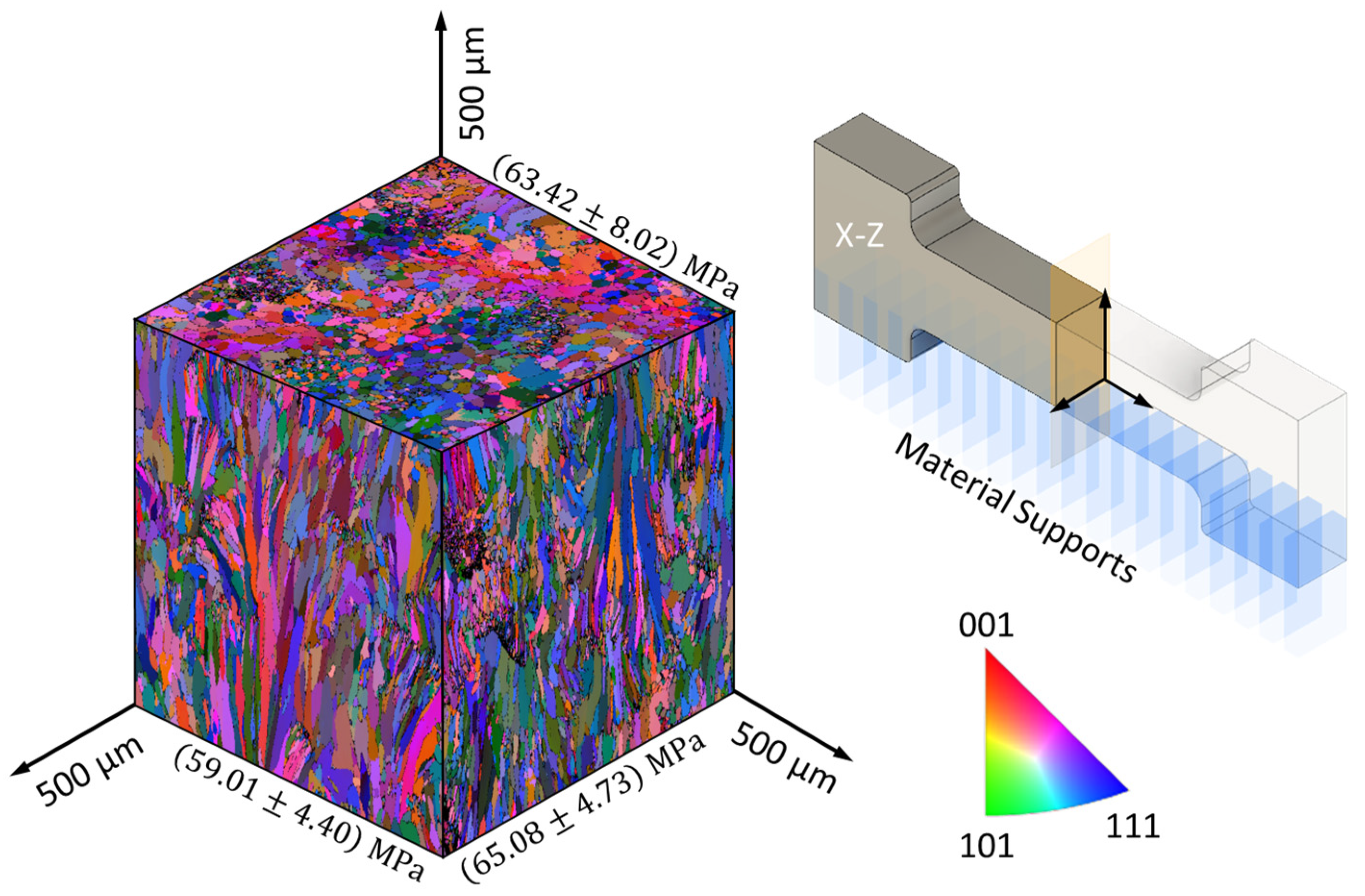

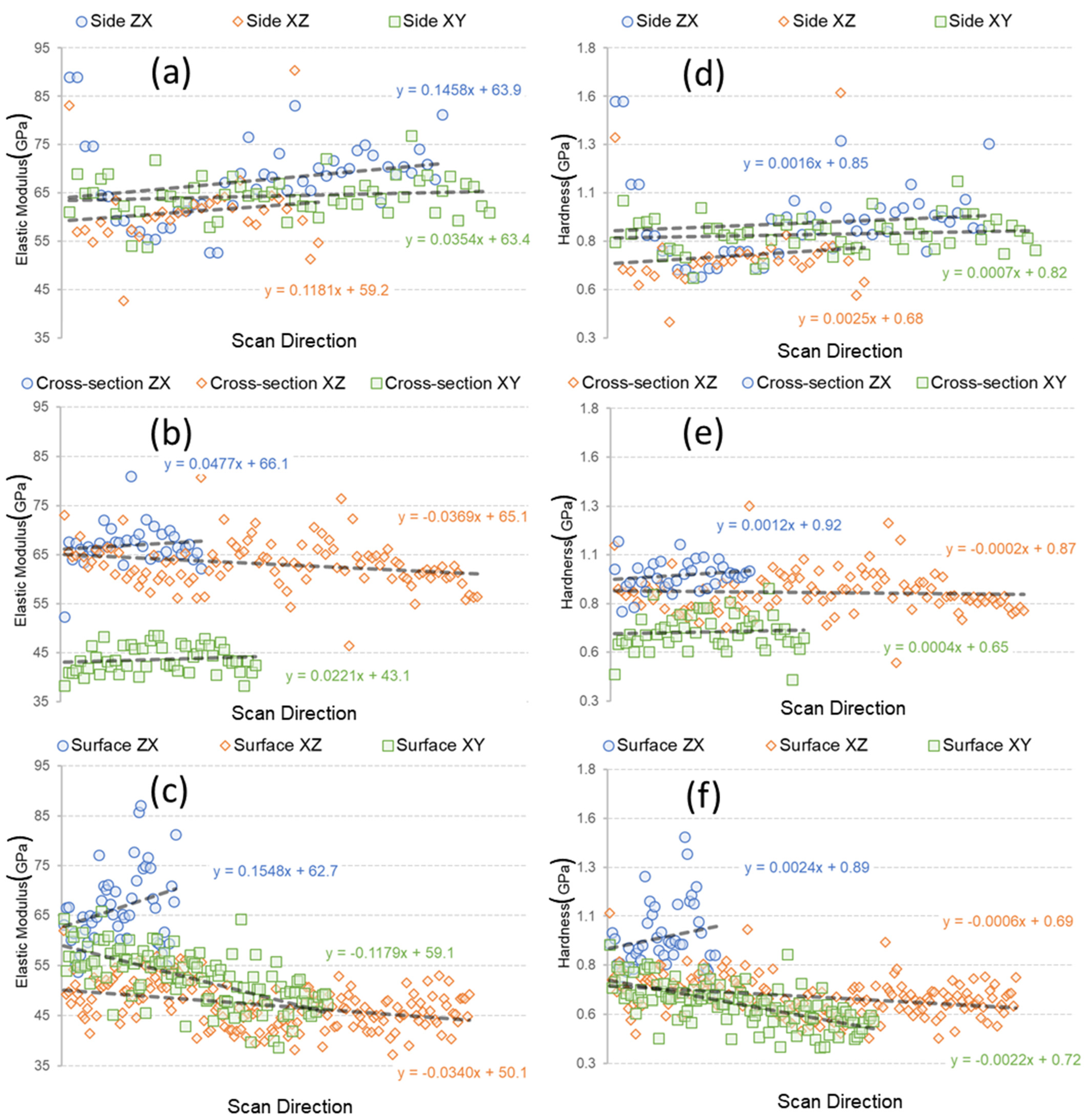
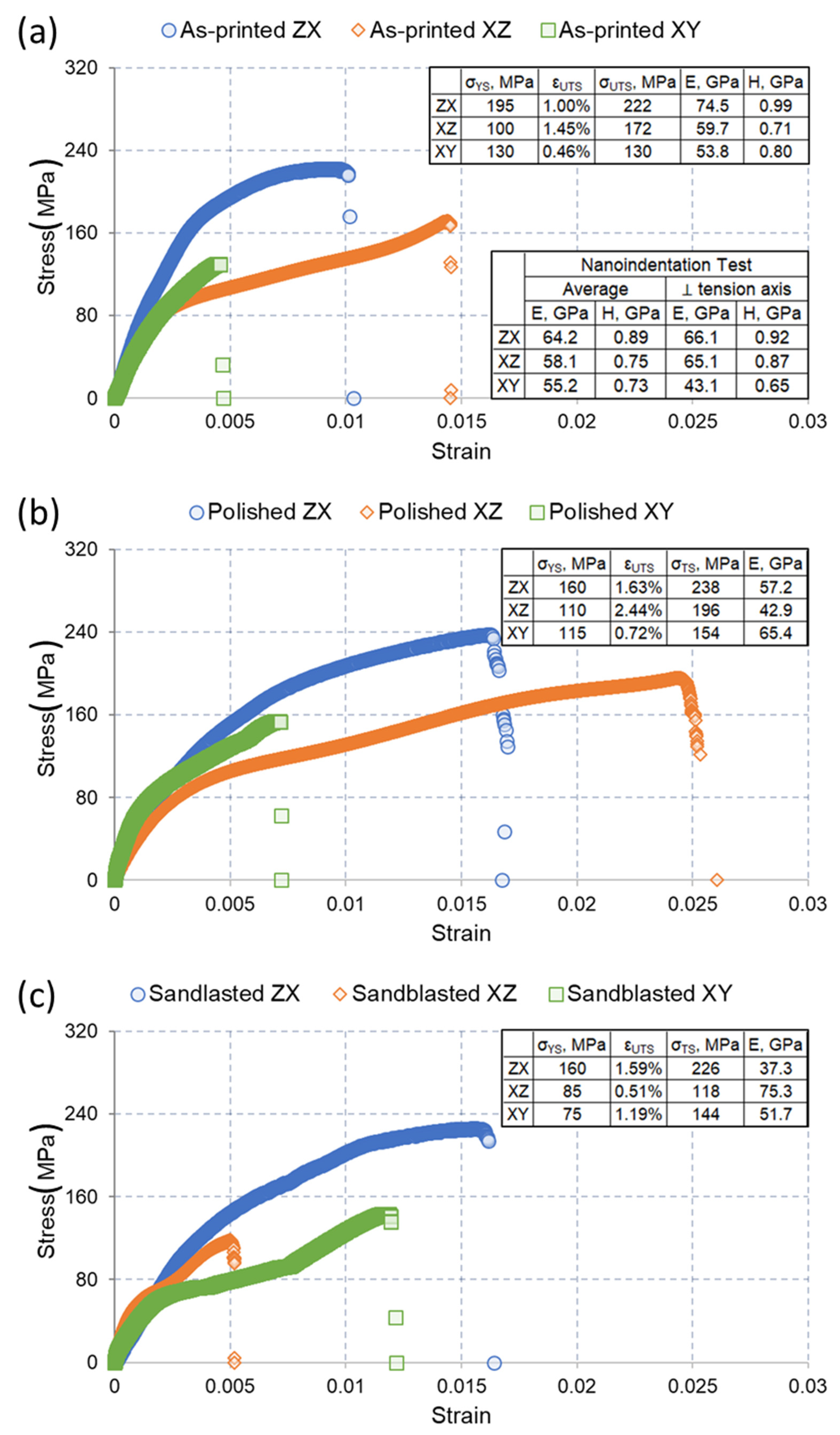
| ZX | XZ | XY | |||||||
|---|---|---|---|---|---|---|---|---|---|
| Length, μm | Width, μm | Aspect Ratio | Length, μm | Width, μm | Aspect Ratio | Length, μm | Width, μm | Aspect Ratio | |
| Surface | 19.7 ± 19.3 | 7.4 ± 5.5 | 2.5 ± 1.3 | 19.3 ± 18.5 | 7.5 ± 5.6 | 2.5 ± 1.2 | 22.3 ± 17.1 | 12.7 ± 9.1 | 1.8 ± 0.5 |
| Side | 20.8 ± 17.9 | 7.6 ± 5.2 | 2.5 ± 1.2 | 11.5 ± 7.2 | 7.1 ± 4.1 | 1.6 ± 0.4 | 13.8 ± 11.8 | 6.4 ± 3.6 | 2.1 ± 0.9 |
| Cross-section | 15.7 ± 9.1 | 9.4 ± 4.8 | 1.7 ± 0.5 | 22.0 ± 18.4 | 8.5 ± 4.4 | 2.5 ± 1.2 | 16.5 ± 16.0 | 6.3 ± 4.0 | 2.5 ± 1.3 |
Publisher’s Note: MDPI stays neutral with regard to jurisdictional claims in published maps and institutional affiliations. |
© 2021 by the authors. Licensee MDPI, Basel, Switzerland. This article is an open access article distributed under the terms and conditions of the Creative Commons Attribution (CC BY) license (https://creativecommons.org/licenses/by/4.0/).
Share and Cite
Somov, P.A.; Statnik, E.S.; Malakhova, Y.V.; Nyaza, K.V.; Salimon, A.I.; Ryabov, D.K.; Korsunsky, A.M. On the Grain Microstructure–Mechanical Properties Relationships in Aluminium Alloy Parts Fabricated by Laser Powder Bed Fusion. Metals 2021, 11, 1175. https://doi.org/10.3390/met11081175
Somov PA, Statnik ES, Malakhova YV, Nyaza KV, Salimon AI, Ryabov DK, Korsunsky AM. On the Grain Microstructure–Mechanical Properties Relationships in Aluminium Alloy Parts Fabricated by Laser Powder Bed Fusion. Metals. 2021; 11(8):1175. https://doi.org/10.3390/met11081175
Chicago/Turabian StyleSomov, Pavel A., Eugene S. Statnik, Yuliya V. Malakhova, Kirill V. Nyaza, Alexey I. Salimon, Dmitry K. Ryabov, and Alexander M. Korsunsky. 2021. "On the Grain Microstructure–Mechanical Properties Relationships in Aluminium Alloy Parts Fabricated by Laser Powder Bed Fusion" Metals 11, no. 8: 1175. https://doi.org/10.3390/met11081175
APA StyleSomov, P. A., Statnik, E. S., Malakhova, Y. V., Nyaza, K. V., Salimon, A. I., Ryabov, D. K., & Korsunsky, A. M. (2021). On the Grain Microstructure–Mechanical Properties Relationships in Aluminium Alloy Parts Fabricated by Laser Powder Bed Fusion. Metals, 11(8), 1175. https://doi.org/10.3390/met11081175








